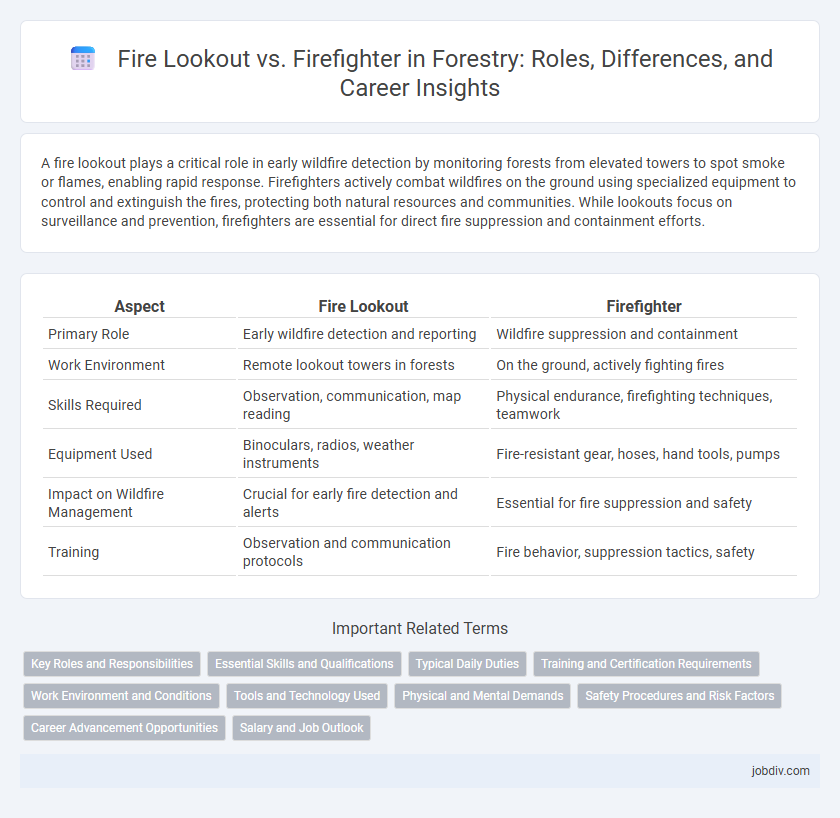A fire lookout plays a critical role in early wildfire detection by monitoring forests from elevated towers to spot smoke or flames, enabling rapid response. Firefighters actively combat wildfires on the ground using specialized equipment to control and extinguish the fires, protecting both natural resources and communities. While lookouts focus on surveillance and prevention, firefighters are essential for direct fire suppression and containment efforts.
Table of Comparison
| Aspect | Fire Lookout | Firefighter |
|---|---|---|
| Primary Role | Early wildfire detection and reporting | Wildfire suppression and containment |
| Work Environment | Remote lookout towers in forests | On the ground, actively fighting fires |
| Skills Required | Observation, communication, map reading | Physical endurance, firefighting techniques, teamwork |
| Equipment Used | Binoculars, radios, weather instruments | Fire-resistant gear, hoses, hand tools, pumps |
| Impact on Wildfire Management | Crucial for early fire detection and alerts | Essential for fire suppression and safety |
| Training | Observation and communication protocols | Fire behavior, suppression tactics, safety |
Key Roles and Responsibilities
Fire Lookouts are primarily responsible for early detection of wildfires by monitoring vast forest areas, using specialized equipment like binoculars and communication radios to report smoke or fire signs promptly. Firefighters engage directly in wildfire suppression, implementing containment strategies such as creating firebreaks, conducting controlled burns, and extinguishing flames to protect natural resources and communities. Both roles are critical in wildfire management, with lookouts focusing on surveillance and rapid reporting, while firefighters execute tactical response actions.
Essential Skills and Qualifications
Fire Lookouts require acute observational skills, strong communication abilities, and proficiency in using fire detection technology such as binoculars and radios to spot early signs of wildfires. Firefighters need physical endurance, expertise in fire suppression techniques, knowledge of hazardous materials, and training in emergency medical response. Both roles demand situational awareness and the ability to operate in remote, high-risk environments to effectively manage wildfire threats.
Typical Daily Duties
Fire lookouts primarily monitor forests from elevated towers, scanning for smoke or fire indicators to provide early warnings, ensuring rapid response to wildfires. Firefighters engage directly in fire suppression, clearing vegetation, constructing firelines, and using water or retardants to extinguish active flames. Both roles require situational awareness and communication skills, but fire lookouts concentrate on detection while firefighters focus on containment and control.
Training and Certification Requirements
Firefighters undergo extensive training in wildfire suppression, often including certification in wildfire behavior, safety protocols, and advanced firefighting techniques through agencies like the National Wildfire Coordinating Group (NWCG). Fire lookout personnel require specialized training focused primarily on fire detection, observation skills, and communication, with certification programs emphasizing situational awareness and early warning systems rather than active suppression. Both roles demand physical fitness and knowledge of forest ecology, but firefighters receive more comprehensive tactical training to engage directly in fire control operations.
Work Environment and Conditions
Fire lookouts operate in remote, elevated towers or isolated forest locations with limited access and exposure to extreme weather conditions, requiring vigilance and stamina during long shifts. Firefighters face dynamic, hazardous environments including dense smoke, high heat, and uneven terrain while actively combating wildfires using physical strength and protective gear. Both roles demand resilience and adaptability, but fire lookouts primarily focus on early detection, whereas firefighters engage directly in fire suppression efforts.
Tools and Technology Used
Fire lookouts primarily rely on high-powered binoculars, panoramic observation towers, and communication radios to detect smoke and coordinate early wildfire alerts. Firefighters use advanced firefighting tools such as drip torches for controlled burns, chainsaws for clearing vegetation, and thermal imaging cameras to locate hotspots during suppression efforts. Both roles increasingly benefit from drones and satellite monitoring systems to enhance situational awareness and improve wildfire management efficiency.
Physical and Mental Demands
Fire lookouts endure prolonged solitude and require acute observational skills to detect smoke and fire signs in remote locations, demanding high mental alertness and resilience. Firefighters face intense physical exertion, including carrying heavy equipment, navigating rough terrain, and battling high temperatures, requiring superior strength, stamina, and stress management. Both roles demand strong situational awareness and decision-making under pressure, but firefighters experience significantly greater physical strain while lookouts manage mental vigilance over extended periods.
Safety Procedures and Risk Factors
Fire lookouts play a crucial role in early wildfire detection by maintaining constant vigilance from elevated observation points, which reduces response time and enhances safety for firefighting teams. Firefighters face higher physical risks, including exposure to intense heat, smoke inhalation, and unpredictable fire behavior, necessitating strict adherence to safety procedures such as wearing protective gear, employing controlled burns, and retreat protocols. Both roles require comprehensive risk assessment and communication systems to minimize hazards and coordinate effective wildfire containment.
Career Advancement Opportunities
Fire lookouts primarily monitor forests for early signs of wildfire, providing critical data that can lead to rapid response and prevention, but their role offers limited direct career advancement outside of supervisory lookout positions. Firefighters engage actively in wildfire suppression and prevention efforts, creating broader career pathways including specialized roles such as fire behavior analyst, wildland fire management officer, and leadership positions within forestry agencies. Skill development, field experience, and training certifications significantly enhance firefighters' prospects for advancement compared to the more observational duties of fire lookouts.
Salary and Job Outlook
Fire lookout positions typically offer lower average salaries, ranging from $25,000 to $40,000 annually, compared to firefighters who earn between $40,000 and $70,000 depending on experience and location. The job outlook for firefighters is strong, with a projected growth rate of about 6% over the next decade due to increased demand for emergency response and wildfire management. Fire lookouts face limited growth opportunities as automation and technological advancements reduce the need for manual surveillance in forestry fire detection.
Fire Lookout vs Firefighter Infographic

 jobdiv.com
jobdiv.com